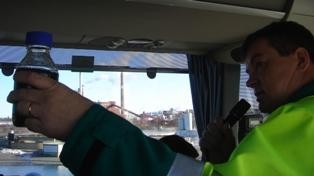Ville Niinistö, Minister of the Environment: a multitude of stakeholders work for the protection the Baltic Sea – and we need them all.

On 14 March, the John Nurminen Foundation participated in a major event organised by the Raumanmeri Rotary Club and the Baltic Sea Challenge at the ice rink of Rauma, a city celebrating its 570th anniversary this year.
Preaching to the converted is a common problem for seminars that focus on the Baltic Sea. The Rauma event was a truly refreshing exception: members of the general public, interested in and concerned about the Baltic Sea, clearly outnumbered the Baltic Sea specialists. Speakers at the event included well-known marine experts and representatives from companies of the water industry, of whom many had personal ties to the Rauma area.
In Rauma, the city and local businesses work together in various fronts. An excellent example of such cooperation is the 10-year-old wastewater treatment plant, shared by the city of Rauma and the forest industry. When the shared treatment plant was being planned, many doubted that a commercial company and the public sector could cooperate successfully. Today, things are different. Kari Pasanen, General Manager at UPM, explained that the benefits of having a shared treatment plant are significant both in terms of cost and the plant’s treatment efficiency. Results are particularly impressive for the removal of nitrogen discharged to the sea.
Compared to the Baltic Sea, the Bothnian Sea is in relatively good condition. Ville Niinistö, Minister of the Environment and keynote speaker at the event, described the poor status of the Baltic Sea as a whole: the bottom of the Baltic Sea is the largest wasteland in Europe, and massive blooms of blue-green algae have come to symbolise international cooperation in the area. During his tenure, Niinistö intends to spare no effort in the battle to improve the status of the Baltic Sea. ‘If I don’t, I won’t be able to show my face in Turku again.’ Ville Niinistö thanked the people of Rauma and the neighbouring regions for their citizen activism, and the businesses for their effort to save the Baltic Sea. Niinistö mentioned that there is a multitude of active stakeholders working for the Baltic Sea, and everybody’s efforts are needed. The minister thanked the John Nurminen Foundation for its operations that combine environmental protection and financial thinking.
Juha Nurminen, Chairman of the Board of the John Nurminen Foundation and Marjukka Porvari, head of the Clean Baltic Sea projects, spoke at the event, emphasising the importance of the work conducted at wastewater treatment plants. Our ability to remove nutrients from toilet wastewaters in the entire draining basin of the Baltic Sea, in line with HELCOM’s wastewater recommendations, is a matter of life or death for the Baltic Sea. Answering host Jami Jokinen’s question on what she would do with unlimited funding, Porvari said, ‘In addition to improving the efficiency of wastewater treatment, I would buy away the farm fields that cause the greatest load to the Archipelago Sea and convert them into some other use that causes less load.’
The event also saw the publication of the Finnish Rotary Club’s action plan to improve the status of the Baltic Sea. The Rotary network and the Baltic Sea Challenge have joined forces in collecting examples of actions that improve the status of the nearby waters and the Baltic Sea. These tips were divided into three groups: concrete projects, increasing awareness, and fundraising for the benefit of organisations that support the Baltic Sea.
The primus motors of the event were Raimo Vahanto from the Raumanmeri Rotary Club, and Lotta Nummelin, Helsinki coordinator of the Baltic Sea Challenge. During the day, enthusiasm amongst the participants and the audience was such that the event will inevitably become an annual tradition.
Johan Nurminen, the great-grandfather of Juha Nurminen, set up the company with the name John Nurminen in Rauma in 1886. The roots of the family business and its history in shipping and transportation can still be seen in the John Nurminen Foundation logo, which bears the text ‘Have no care! Let Nurminen carry your load.’ (In Finnish, ‘Älä Wälit! Ann Nurmise wälittä’)
